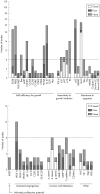Immunohistochemical markers of prognosis in non-small cell lung cancer: a review and proposal for a multiphase approach to marker evaluation
- PMID: 16873561
- PMCID: PMC1860456
- DOI: 10.1136/jcp.2005.031351
Immunohistochemical markers of prognosis in non-small cell lung cancer: a review and proposal for a multiphase approach to marker evaluation
Abstract
Characteristics of the tumour that affect and predict the survival outcome of patients with cancer are prognostic markers for cancer. In non-small cell lung carcinoma (NSCLC), stage is the main determinant of prognosis and the basis for deciding options for treatment. Patients with early-stage tumour are treated by complete surgical resection, which is curative in 40-70% of patients. That there are other factors important in determining the biology of these tumours, especially genes that have a role in metastasis, is indicated. Such factors could potentially be used to further classify patients into groups according to substages that may be treated differently. During the past decade, a large number of proteins that are putatively important in carcinogenesis and cancer biology have been studied for their prognostic value in NSCLC, but none of them have been proved to be sufficiently useful in clinical diagnosis. Several markers (epidermal growth factor receptor, human epidermal growth factor receptor 2, Ki-67, p53 and Bcl-2) have been studied exhaustively. Ki-67, p53 and Bcl-2 are suggested to be important but weak prognostic markers, by meta-analyses of the results. Cyclin E, vascular endothelial growth factor A, p16(INK4A), p27(kip1) and beta-catenin are promising candidates, but require further study in large randomised clinical trial samples by using standardised assays and scoring systems. Some issues and inconsistencies in the reported studies to date are highlighted and discussed. A guideline for a multi-phase approach for conducting future studies on prognostic immunohistochemistry markers is proposed here.
Conflict of interest statement
Competing interests: None.
References
-
- Mountain C F. The international system for staging lung cancer. Semin Surg Oncol 200018106–115. - PubMed
-
- Hanahan D, Weinberg R A. The hallmarks of cancer. Cell 200010057–70. - PubMed
-
- Sieber O M, Heinimann K, Tomlinson I P. Genomic instability—the engine of tumorigenesis? Nat Rev Cancer 20033701–708. - PubMed
-
- Sporn M B, Todaro G J. Autocrine secretion and malignant transformation of cells. N Engl J Med 1980303878–880. - PubMed
-
- Mosesson Y, Yarden Y. Oncogenic growth factor receptors: implications for signal transduction therapy. Semin Cancer Biol 200414262–270. - PubMed
Publication types
MeSH terms
Substances
LinkOut - more resources
Full Text Sources
Other Literature Sources
Medical
Research Materials
Miscellaneous

